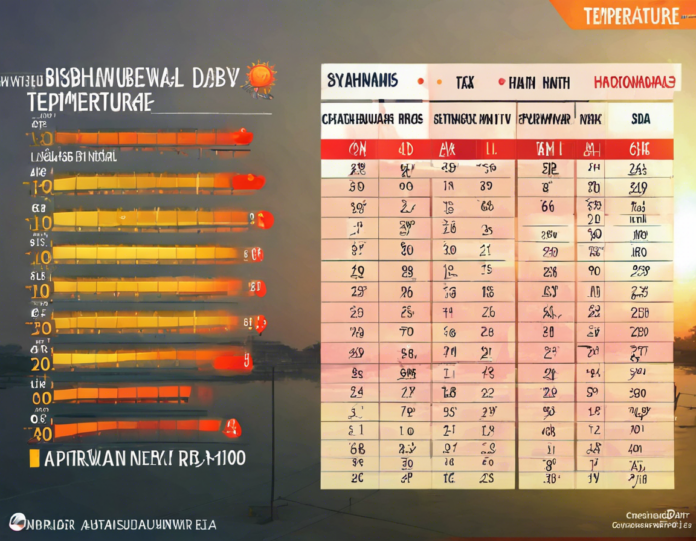Introduction
Bhubaneswar, the capital city of the Indian state of Odisha, is known for its rich cultural heritage, ancient temples, and bustling markets. Situated on the eastern coast of India, Bhubaneswar experiences a tropical savanna climate characterized by hot and humid summers, moderately cold winters, and monsoon rains. In this article, we will explore the weather patterns and temperature fluctuations that Bhubaneswar experiences throughout the year.
Seasonal Overview
-
Summer (March to June): During summer, Bhubaneswar experiences scorching heat with temperatures soaring as high as 45°C. The city remains dry with low humidity levels, making it an uncomfortable time for outdoor activities.
-
Monsoon (July to September): The monsoon season brings relief from the summer heat, with frequent rainfall and cooling temperatures. However, heavy rains and occasional cyclones can result in flooding and disruption of daily life.
-
Autumn (October to November): Autumn brings pleasant weather to Bhubaneswar, with clear skies and moderate temperatures. It is considered one of the best times to visit the city to explore its numerous attractions.
-
Winter (December to February): Winter in Bhubaneswar is characterized by cool weather and comfortable temperatures ranging from 15°C to 28°C. While the nights can get chilly, daytime temperatures are perfect for exploring the city.
Factors Influencing Weather
-
Geographical Location: Bhubaneswar’s proximity to the Bay of Bengal influences its weather patterns, with the sea acting as a source of moisture and humidity during the monsoon season.
-
Topography: The city’s flat terrain allows for the easy movement of weather systems, resulting in consistent temperatures throughout the region.
-
Urbanization: Rapid urbanization and concrete structures in Bhubaneswar have led to the formation of heat islands, contributing to increased temperatures in certain areas.
Temperature Fluctuations
-
Day-Night Variations: Bhubaneswar experiences significant temperature fluctuations between day and night, with daytime temperatures being much higher compared to the cooler nights.
-
Monthly Averages: The average temperature in Bhubaneswar ranges from 25°C to 32°C throughout the year, with higher peaks during the summer months and cooler lows in winter.
-
Record Highs and Lows: The highest temperature recorded in Bhubaneswar was 46.8°C, while the lowest temperature dropped to 7.1°C.
Climate Change Impact
The impact of climate change on Bhubaneswar’s weather patterns is becoming increasingly evident. Rising temperatures, erratic rainfall, and extreme weather events are becoming more frequent, posing challenges for the city’s infrastructure and residents.
Tips for Weather Preparedness
-
Stay Hydrated: During the summer months, it is crucial to stay hydrated by drinking plenty of water and avoiding prolonged exposure to the sun.
-
Dress Appropriately: Wear light and breathable clothing in summer, and layer up with warm clothing in winter to stay comfortable.
-
Monitor Weather Updates: Keep track of weather forecasts and warnings, especially during the monsoon season, to stay safe during heavy rainfall events.
-
Prepare for Cyclones: Bhubaneswar is prone to cyclones during the monsoon season, so it is essential to have an emergency kit ready with essentials like food, water, and first aid supplies.
Conclusion
Bhubaneswar’s weather and temperature fluctuations offer a diverse experience for residents and visitors throughout the year. By understanding the seasonal patterns and being prepared for weather extremes, one can make the most of their time in this vibrant city.
Frequently Asked Questions (FAQs)
- **What is the best time to visit Bhubaneswar?
-
The best time to visit Bhubaneswar is during the autumn months of October and November when the weather is pleasant and conducive for sightseeing.
-
**Does Bhubaneswar experience extreme weather events?
-
Yes, Bhubaneswar is prone to cyclones and heavy rainfall during the monsoon season, which can lead to flooding and disrupt daily life.
-
**How should I dress for Bhubaneswar’s weather?
-
It is advisable to wear light and breathable clothing during the summer months and to layer up with warm clothing in winter to stay comfortable.
-
**Are there any precautions to take during the summer in Bhubaneswar?
-
Stay hydrated, avoid prolonged sun exposure, and seek shade when outdoors to prevent heat-related illnesses during the summer.
-
**What is the average temperature range in Bhubaneswar?
-
The average temperature in Bhubaneswar ranges from 25°C to 32°C throughout the year, with variations depending on the season.
-
**How does urbanization impact Bhubaneswar’s weather?
-
Rapid urbanization and concrete structures in Bhubaneswar have led to the formation of heat islands, contributing to increased temperatures in certain areas.
-
**Is Bhubaneswar affected by climate change?
-
Yes, Bhubaneswar is experiencing the impact of climate change through rising temperatures, erratic rainfall, and more frequent extreme weather events.
-
**What can I do to stay safe during cyclones in Bhubaneswar?
-
It is essential to have an emergency kit ready with essentials like food, water, and first aid supplies, and to follow official warnings and evacuation orders during cyclones.
-
**How do temperature fluctuations impact daily life in Bhubaneswar?
-
Temperature fluctuations between day and night can affect energy consumption, agricultural practices, and overall comfort levels for residents in Bhubaneswar.
-
**Are there any specific precautions for travelers visiting Bhubaneswar?
- Travelers should be prepared for weather changes, carry necessary medications, and stay informed about local weather conditions to ensure a safe and enjoyable trip to Bhubaneswar.












